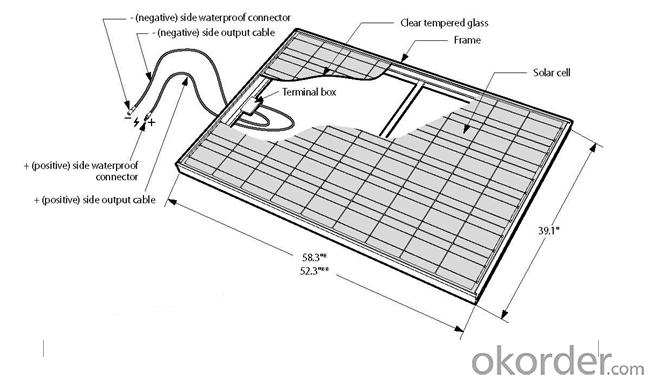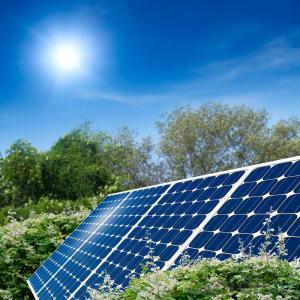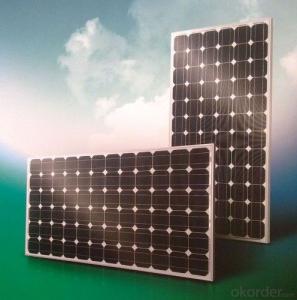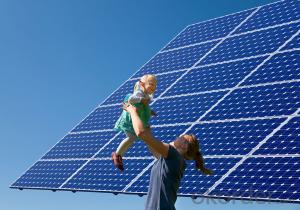CNBM Solar Monocrystalline 125mm Series (20W—25W)
- Loading Port:
- China main port
- Payment Terms:
- TT OR LC
- Min Order Qty:
- 100000 watt
- Supply Capability:
- 10000000 watt/month
OKorder Service Pledge
OKorder Financial Service
You Might Also Like
About us
CNBM International Corp, established in 2004, is the business entity for trade and logistic of CNBM Group.With the advantages in Cement, Composite Materials, New Building Materials and Engineering, CNBM mainly concentrate on coal, steel and construction equipments and give priority to solar and wind energy development.CNBM International is highly recognized by its business partners and clients all over the world and has established good business relationship with the customers in over 120 countries and regions all over the world.
Wiring
To ensure proper system operation to maintain your warranty, observe the correct cable connection polarity(Figures 1&2) when connecting the modules to a battery or to other modules. If not connected correctly, the bypass diode could be destroyed.
PV modules can be wired in series to increase voltage. Connect wires from the positive terminal of one module to the negative of the next module. Figure shows modules connected in series .
Components

Data sheet
| Characteristics | |
| Max Power Voltage Vmp (V) | 17.8V-18.2V |
| Max Power Current Imp (A) | 1.13A-1.28A |
| Open Circuit Voltage Voc (V) | 22.2V-22.4V |
| Short Circuit Current Isc (A) | 1.29A-1.61A |
| Max Power Pm (W) | 20W-25W |
| Temperature Coefficient of Cells | |
| NOCT | 47℃±2℃ |
| Temperature Coefficients of Isc (%/℃) | 0.06% |
| Temperature Coefficients of Voc (%/℃) | -0.33% |
| Temperature Coefficients of Pmp (%/℃) | -0.45% |
| Mechanical Data | |
| Type of Cells (mm) | Mono125×31.25 |
| Dimension | 650×290×25mm |
| Weight | 2.2kg |
| NO.of Cells and Connections | 2×18=36 |
| Limits | |
| Operating Temperature | –45°C to +80°C |
| Storage Temperature | –45°C to +80°C |
| Max System Voltage | 700V |
Guarantee
Products Guarantee 2 yrs free from defects in materials and workmanship
Performance Guarantee No less than 90% within 10yrs and no less than 80% within 20yrs Certificates IEC, ISO, CE
- Q:Can solar panels be used for heating water?
- Yes, solar panels can be used for heating water. Solar thermal systems or solar water heaters use solar energy to heat water by capturing sunlight and converting it into heat energy. This heat is then transferred to a fluid, which is used to heat the water in a storage tank. This sustainable and cost-effective method can be used for residential, commercial, and industrial water heating purposes.
- Q:How do solar panels impact the energy independence of a region?
- Solar panels can greatly enhance the energy independence of a region by providing a clean and renewable source of electricity. By harnessing the power of the sun, solar panels reduce the dependence on non-renewable energy sources such as fossil fuels. This reduces the need for importing energy from other regions, thus enhancing the region's energy independence. Additionally, solar panels can be installed on rooftops and other available spaces, allowing individuals and communities to generate their own electricity and become less reliant on the traditional energy grid. Overall, solar panels contribute to a more sustainable and self-sufficient energy future for the region.
- Q:Hi everyone, I am a novice in solar energy system. I want to know if I am on the right track. Recently I bought a 30 W solar panel, 5 Amp controller, and a 22 Ah battery, how many watts and what kind of INVERTER do I need? I did an research some said 50 W and some said 300 W. And am I right on the 5 amp controller and 22 Ah battery to provide larger output of electric, or the higher the # the greater output for 30 W solar panel?Really appreciate for anyone who help!!!
- With a 30 watt panel, producing about 2 amps, your not going to have much power from that. A 22 AH battery will give you 2 AH of usage. A battery should never be drained below 50%. What this works out to be is simply Amp draw for 2 hours. Which equals to 2V light bulb that draws amp for 2 hours. Not much. Now to replace that usage with your 30 watt panel, provided the panel is clean and in max sunlight, it will take 6 hours. If you attach an inverter to your system for 5 Volt Usage then the DC voltage drawn from the battery is very high. Example: Say you use a 5 Volt component that requires 50 Watts per hour to operate. The inverter will draw 5 Amps out of the Battery every hour to operate that component. That gives you and /2 of use before the battery is down to 50%.. Maybe that will be enough to charge up a standard Laptop battery. I have 2 30 Watt panels that produce 5 Amps, 4 6V batteries that have 480 AH and a 25 Amp Controller with a booster that increase the amp output to 20 Amps per hour. I live full time in an RV and raise the panels to get max output when I am parked. This system provides me with all the 5V throught the 500 Watt inverter that I need. Good luck on you system.
- Q:I know that if I put solar panels in my home I will get 30% back from the govt. Does that mean if I pay 2K I will get back around a 3K check? Or will my income play a roll where I may not get back as much?
- The Tax Lady is almost always right, but I must disagree on the $500 limitation concerning a solar electric system (from the price, it sounds like that's what the original question was about) installed in 20. If there was such a change, there would have been an outcry on the solar installers' forum I visit, just as there was jubilation when the limit on the tax credit was removed a few years ago.
- Q:How much energy can be generated from a solar panel on a clear, bright summer's day for example?
- it depends on the size of the panel and if it is installed in an optimal location. there are many 00W panels commercially available and they can be ganged for a number of different output configurations.
- Q:Can solar panels be installed on a recreational vehicle (RV)?
- Yes, solar panels can be installed on a recreational vehicle (RV). Many RV owners choose to install solar panels on their vehicles to generate electricity and reduce their reliance on traditional power sources while on the road. Solar panels can provide a sustainable and eco-friendly solution for powering various appliances and systems in an RV, making it more self-sufficient and energy-efficient.
- Q:I have an electric bicycle that I travel to work by, pulling a modified child carrying trailer that holds two 2 volt deep cycle batteries in series to power the 24 volt bike motor. I'm thinking about adding a 50 watt solar panel (or larger depending on the room I can make available) to charge while I'm at work and to provide some extra juice while on my more distant travels.Can I get a solar panel to charge them while they're connected the way they are: in series? Does charging work that way?I've read that in order to charge the 24 volt battery setup (if the answer to the Q above is yes), the output from my solar panel would need to be a little more than 24 volts. Is this true? If so, how many volts?Since the bike is supposed to be powered at 24 volts and I have an x-volt (x gt; 24v) solar panel connected to it, will this cause any damage to the controller or other components while running them?Will it help supply power even while the motor is being run?Thanks.
- Yes, you have it right you need two 2V panels wired in series to give 24V to charge a 24 volt system. But along with the 24V you also want some amperage, otherwise it takes forever to charge. Most of the little chargers are called trickle charges because they only have an amp or two. If you had two 25 watt solar panels putting out 24V you have : watts = volts * amps 50 watt = 24V * x amps x = 2 amps If your battery is say 50 amp hours of storage, then if you are putting in 2 amps it will take you 25 hours of sunlight to power it back up from a dead battery. So the charge time depends on how many amps you are putting in there at 24V A car battery charger typically charges at 0 amps at 2V, so 2 * 0 = 20 watts of power going in there So if you go solar make sure to use a charge controller and a big enough panel to get close to 00 watts for any decent recharge time. The charge controller makes sure that the battery only gets voltage going one way and it least 24V. So if the sun went behind some clouds and the voltage dropped to 20V, the controller shuts off the current until the voltage equals 24V or more
- Q:a) i'd like to get a solar panel to make this thing i saw in popular science, it was a bag that had a solar panel in the side (you just attach it with grommets into a clear vinyl pocket you make. its for charging elecronics and stuff) and i was wondering what kind i should look at, do they come flexible? can i get them on OKorder? what kind of wattage should i look for (btw it also had a little voltage regulator and stuff to make a little usb in your bag) so any info on that!b) i was thinking about like putting solar panels on my roof, where can i look into that, is that a good choice, has anyone done it, how did it work out? thank you, just curious
- For okorder / for information on how to hooke it up your self. It is a DIY site.
- Q:ASAP :) as much details as possible
- Build okorder /
- Q:Can solar panels be installed on a fire station or emergency services building?
- Yes, solar panels can be installed on a fire station or emergency services building. In fact, many fire stations and emergency services buildings have embraced solar energy as a sustainable and cost-effective solution. Solar panels can help these facilities generate their own electricity, reduce utility bills, and lower their carbon footprint. Additionally, the availability of rooftop space on such buildings often makes them suitable for solar panel installation.
1. Manufacturer Overview |
|
|---|---|
| Location | |
| Year Established | |
| Annual Output Value | |
| Main Markets | |
| Company Certifications | |
2. Manufacturer Certificates |
|
|---|---|
| a) Certification Name | |
| Range | |
| Reference | |
| Validity Period | |
3. Manufacturer Capability |
|
|---|---|
| a)Trade Capacity | |
| Nearest Port | |
| Export Percentage | |
| No.of Employees in Trade Department | |
| Language Spoken: | |
| b)Factory Information | |
| Factory Size: | |
| No. of Production Lines | |
| Contract Manufacturing | |
| Product Price Range | |
Send your message to us
CNBM Solar Monocrystalline 125mm Series (20W—25W)
- Loading Port:
- China main port
- Payment Terms:
- TT OR LC
- Min Order Qty:
- 100000 watt
- Supply Capability:
- 10000000 watt/month
OKorder Service Pledge
OKorder Financial Service
Similar products
New products
Hot products
Related keywords





























